Going on a winter adventure in your camper can be an extremely exciting part of both part-time and full-time RV living!
However, trying to stay warm during winter RV camping trips can be quite a challenge.
Freezing temperatures can detract from an otherwise great trip.
That being said, you don’t have to shell out for a fancy motorhome to stay toasty in the cold. There are plenty of ways — more than you might think — to warm up your RV when winter tightens its grip.
These range from modifications to the RV itself to tried-and-true RV winterizing products and accessories.
There are options to suit different budgets, travel trailers, and people.
Read on to discover great RV tips and techniques for keeping your camper or small fifth wheel warm this winter.
Table of Contents
- 1. Stay On Top Of Repairs
- 2. Insulate Your Camper from Top To Bottom
- 3. Insulate Water Tanks, Hoses, And Pipes
- 4. Protect Your Camper’s Underbelly
- 5. Don’t Forget Your Windows
- 6. Protect And Insulate Your Vents
- 7. Use Heaters Inside
- 8. Take Advantage Of Winter Accessories
- 9. Research Your Campsite Carefully
- 10. Use Your Oven
- Conclusion
1. Stay On Top Of Repairs
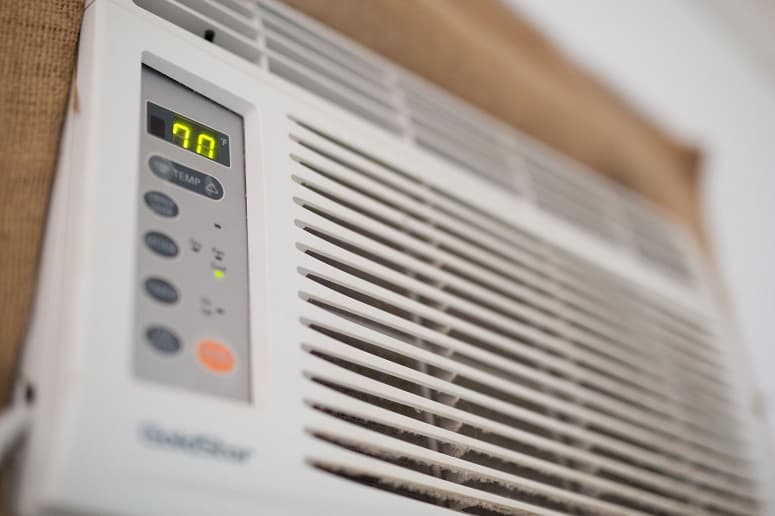
Before you get started on modifying your RV for the cold winter days, take a moment to inspect it thoroughly.
It’s important to make sure your trailer is in tip-top shape before you make any changes.
Minor problems can become major issues in harsh temperatures. It’s also unwise to begin adding things like insulation before you sort out pre-existing problems.
For example, you’ll want to fix any holes in the roof or cracks in the floor before starting any RV upgrades and mods.
Check your RV (including the slide-outs) for water damage and delamination; humidity can be a problem in the winter months too. Don’t allow water damage to get worse by waiting until spring to take action.
Delamination — cracks in the protective outer layer of your RV — can be serious. It could also exacerbate water damage and cause further problems. The earlier you catch it, the less costly the repairs will be.
Discover how to check your RV for water damage and delamination here:
There are also other issues that can make it difficult to keep your camper warm. If you have loose windows or your door doesn’t close correctly, cold air will get in.
Take time to make sure everything is sealed tightly before starting to winterize your vehicle.
- No Longer Available
Foil Insulation
Foil is an excellent temperature regulator; there’s a reason we use aluminum foil to keep food hot.
As a bonus, foil-based insulation is effective against both the cold and the heat.
This means your recreational vehicle will be protected from extreme temperatures year-round.
You can purchase basic blanket-type foil insulation because it’s really easy to install (for more product information, check the Amazon link).
However, it’s good to know that other types of foil insulation come with added benefits, such as resistance to humidity and pests.
3. Insulate Water Tanks, Hoses, And Pipes
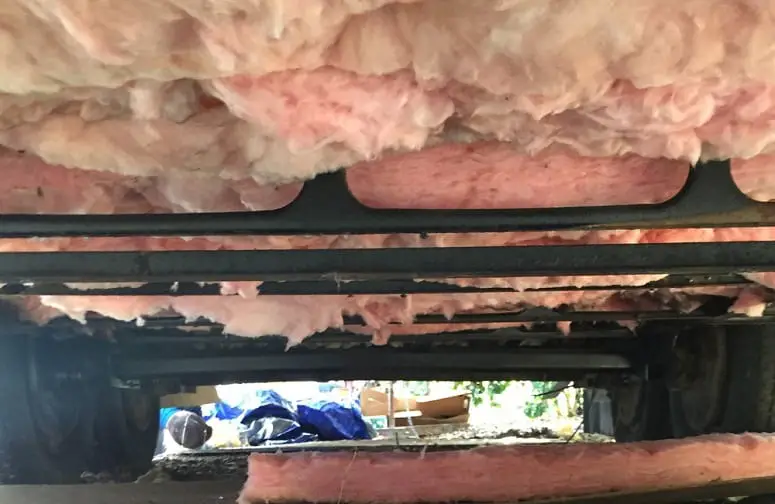
Keeping your pipes, water hoses, and water holding tanks warm in the winter is mandatory.
Cracked freshwater tanks can spoil your trip and are expensive to replace. Plus, it’s quite difficult to stay warm and clean if you don’t have access to hot water.
Preventing pipes from freezing will save you a lot of hassle out in the cold.
Get a heating cable for your pipes to prevent blockages.
You can also buy heating pads for your elbow pipes.
As for your water tanks, you can use a heating blanket to make sure they don’t freeze.
Always ensure the product you buy is large (or small) enough for your tanks.
You can use specialized RV antifreeze in your grey and black tanks (flush some down your toilet), but never in your freshwater tank and water heater!
No products found.
4. Protect Your Camper’s Underbelly
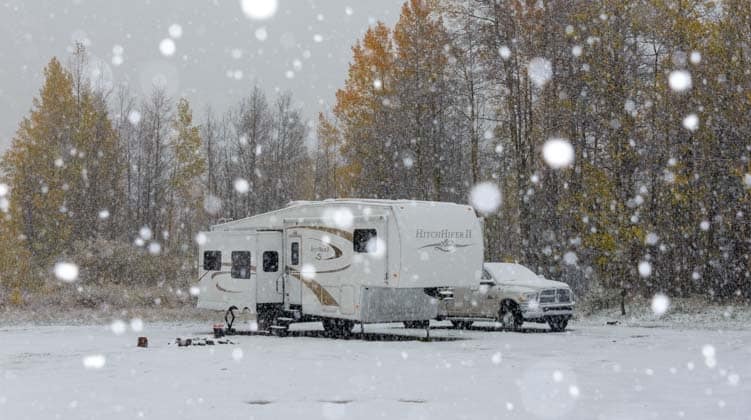
Insulation will not be as effective if your RV’s underbody is exposed.
Chilly winds blowing underneath the RV can result in a temperature drop inside.
Insulating The Underbelly
You can go all-out and insulate the underbody of your recreational vehicle. If you choose to go down the DIY road, be aware of the effort involved.
You may have to use multiple products (e.g. spray foam and foil) to be sure the whole underbody is protected.
Installing An RV Skirt
Don’t worry if insulating your RV’s underbody isn’t an option for you. You can get a skirt for your RV to keep harsh winds from circulating underneath it.
As with insulation, skirting comes in a range of materials, including a weather-resistant one, foam boarding, and plywood. Some types are permanent fixtures, whereas others can be packed away after use.
You can have a custom-made skirt fitted to your camper by a professional company.
However, this option tends to be pricier than buying your preferred material and doing the skirting yourself.
Check out how to skirt your RV with foam insulation boards in the video above.
5. Don’t Forget Your Windows

Your camper windows can be responsible for a lot of heat loss.
There are plenty of options, including budget-friendly ones, to get your windows winter-ready.
Dual Pane Windows
If you’re looking to upgrade your RV, replacing your windows is a great way to go.
As the name suggests, dual-pane windows have two layers of glass for extra insulation.
Replacing your recreational vehicle’s windows is best done with the help of a company specialized in RV glass.
Don’t go for the cheapest option when it comes to dual-pane glass.
Poor-quality double-paned windows can be as ineffective against the cold as single-pane glass.
Window Coverings
If you don’t have the budget for dual-pane glass, try window coverings.
There’s a wide variety of options for blocking out your camper’s windows to keep the warm air in.
Shrink wrap insulation kits are inexpensive and easily installed. If you don’t mind blocking your view for the night, put up foil insulation panels.
Foam seal tape can also be applied around your windows to prevent drafts.
You can even insulate the windows on your travel trailer’s door. Use an insulator with hooks to set up and remove without any hassle.
No products found.
6. Protect And Insulate Your Vents
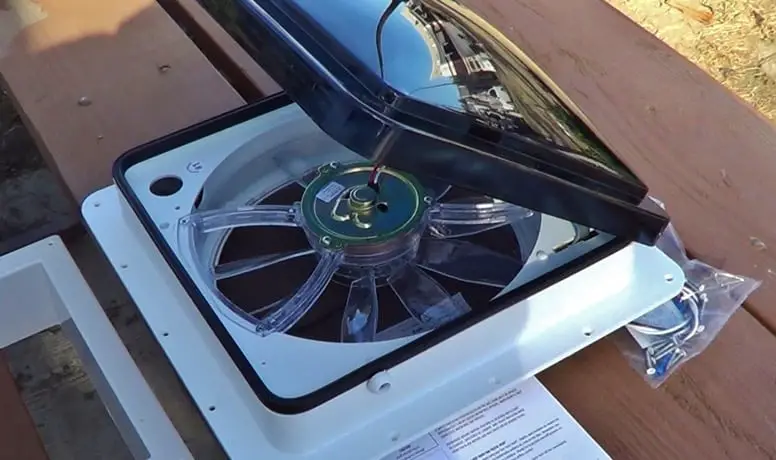
Uncovered vents can ruin all your insulation efforts.
Making use of vent covers can significantly reduce heat loss.
Cover your RV vents externally with a standard roof vent cover.
This will reduce the amount of cold air that gets in and prevent snow and rain from entering your vehicle.
As for internal vent protection, make sure your vents are insulated. An insulating foam vent cover can be neatly fitted into most standard-sized vents.
When you need to use your vents again, just pop it out.
If you have non-standard-sized vents, you can make your own cover. Use your insulation material of choice and cut it to fit your vent.
Please note that covering your vents means things can get humid inside.
This is particularly true if the rest of your RV is sealed up tight against the cold. As we all know, moisture is not good for RVs in the long term.
Combat the humidity with a dehumidifier.
These handy gadgets will stop condensation from building up on your windows, thus reducing the risk of mold and mildew.
Since most campers are not large, small and portable is the way to go. Consider how much noise you can tolerate, as some dehumidifiers can be quite loud.
- ADVANCED DESIGN: Low-profile aerodynamic design offers high-flow...
- WIDELY APPLICABLE: Universal to all 14"X14" Roof Vent Cover and easy...
- EXCELLENT QUALITY MATERIAL: Made from ABS plastic and galvanized iron,...
7. Use Heaters Inside

Don’t be afraid to use heaters. A good heater can make a big difference when it comes to the temperature inside your RV. You can find safe, RV-appropriate heaters of all types.
Safety is the primary concern when it comes to putting a heater in your RV. Small spaces and hot appliances can be a dangerous mix.
Knocking over a heater can result in you (or your belongings) getting burned. Or even worse, you could end up with a fire.
If you decide to go with a propane heater, get one that has failsafe mechanisms in place.
This heater, for example, will shut itself off if oxygen levels get too low.
Additionally, if anyone tips it over, it will turn off automatically.
If you prefer an electric heater, look for the same quality in terms of safety.
This portable space heater stays cool to the touch while working to avoid burns.
It also has a function to avoid overheating in case you leave it on for too long.
If you’re looking for something more luxurious, there are high-end heaters on the market.
The Lasko Ceramic Space Heater allows you to select the exact temperature you want (either in degrees Fahrenheit or Celsius) and comes with a remote control.
- Heat your camper, cabin, porch, picnic area, garage, barn, shed,...
- Gives off 4,000, 9,000, or 18,000 BTU per hour with a heat range of...
- Single control start knob for easy use with a piezo sparking mechanism...
8. Take Advantage Of Winter Accessories

If your goal is to keep warm, insulating yourself is just as important as insulating your camper.
The right cold-weather accessories can be a big help.
Blankets
The wrong blanket can lead to chilly nights, despite your best efforts. Think about getting a plush, microfiber blanket for warm nights in your RV.
This material is breathable, which means you don’t have to worry about overheating.
If you want something with a little extra heat, buy an electric blanket.
This model is non-hazardous and will automatically shut off after 10 hours of use.
- [Premium Bedding Fabrics] Our heated throw blanket is made of fluffy...
- [Superior Heating Technology] 4 heating levels from 86°F to 113°F...
- [Safety Protection] ETL certified, Woomer heated throw blanket is...
Clothes
When packing, don’t forget to bring along warm, comfortable indoor clothing. Choose heavy pajamas, thermal leggings, and warm sweaters.
Don’t forget to keep your feet warm too! Insulated socks will protect your toes from freezing inside and outside your RV.
OUR WINTER JACKET RECOMMENDATION
Rugs
It’s worthwhile to cover your RV floors with carpets, at least for the winter. Even in socks, a bare RV floor can be shockingly cold.
A carpet will add an additional layer of insulation and make your RV more inviting.
If you find a carpet or a rug that you like but it’s too large for your camper, you can always cut it down.
- Innovative Design and Unique Style: People fall in love with the faux...
- Premium Fluffy Home Decor Rug: This stylish furry rug has the extreme...
- Care Instructions: Simply vacuum with a hand-held vacuum, or shake off...
9. Research Your Campsite Carefully
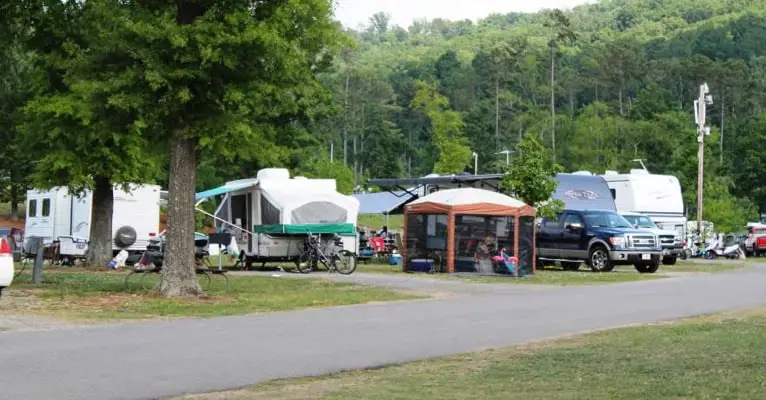
Particularly in the winter, researching your destination is a necessary precaution.
Your favorite place for camping in the summer can be a drastically different environment in the winter.
You need to get an idea of what the weather conditions are like before bringing your RV out. Enjoying the winter weather is fine, but getting stuck in a blizzard is definitely not.
Once you reach the campsite, monitor the area before setting up your camper. Park your recreational vehicle where it won’t be shielded from the sun.
Direct exposure to sunlight can heat your RV up during the day. Even if the sun makes infrequent appearances, every little bit can help.
If possible, try to shield your recreational vehicle from strong, icy winds. This is usually an issue at high altitudes.
Find a sheltered place to set up where your RV will be minimally affected.
10. Use Your Oven

Your RV oven is a great heat source!
Unlike during the summer months, using your oven in the winter is something to look forward to.
After a long day of outdoor activities, why not prepare a hearty meal?
Using your oven will generate heat, particularly for meals that take a lot of time to cook.
As an added bonus, your RV will be infused with the smell of whatever you’ll be cooking.
You might want to avoid onion-heavy dishes though — try cookies or casseroles instead.
Leave your oven door open for a while after you are done cooking. The remaining heat will dissipate in your vehicle.
Be extremely careful when doing this if you have children and/or animal companions on board.
- Portable & Versatile: Our Camp Chef Outdoor Oven is perfect for...
- High Temperature: This outdoor oven has the ability to reach...
- Long-Lasting Heat: With a 1 lb. propane bottle, this outdoor oven can...
Conclusion
Now you know all the ways you can heat up your RV.
I’m sure it’s a relief to know there are other strategies besides buying a new RV furnace.
Camping in the chilly winter months can be a wonderful experience, but being uncomfortably cold in your camper the whole time could make you fall out of love with winter camping permanently.
With thoughtful preparations and a few investments, you can fully enjoy your winter camping trip. Staying warm and dry in an RV is 100% achievable.
Did this article give you any ideas on how to heat up your camper in the winter? Do you know of any other techniques for keeping an RV warm? Feel free to let us know in the comment section below and share this article with fellow RVers and anyone else who enjoys full-time RVing and/or boondocking!


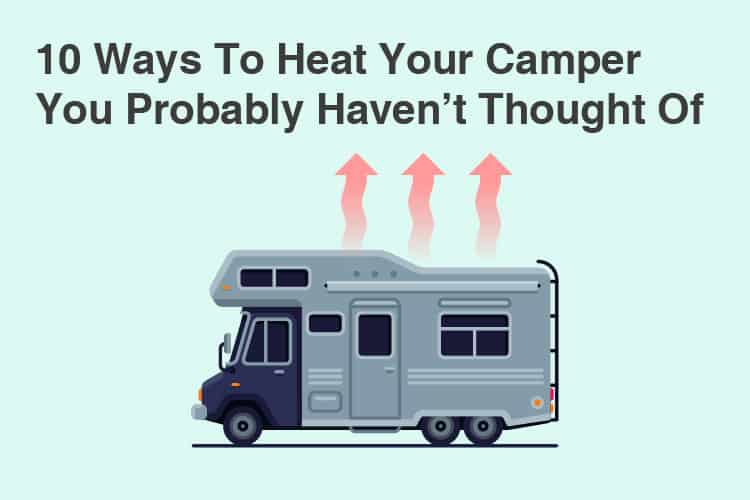




![10 Ways Of Heating Your Camper You Probably Haven’t Thought Of 14 [5 Year Warranty] WOOMER Electric Heated Throw Blanket(50'x 60'), Soft Flannel Fast Heating Blanket with Multi-Color Option, 4 Heating Levels & 4H Auto Off, Machine Washable, Over-Heat Protection](https://m.media-amazon.com/images/I/51S9zGQbMcL._SL160_.jpg)





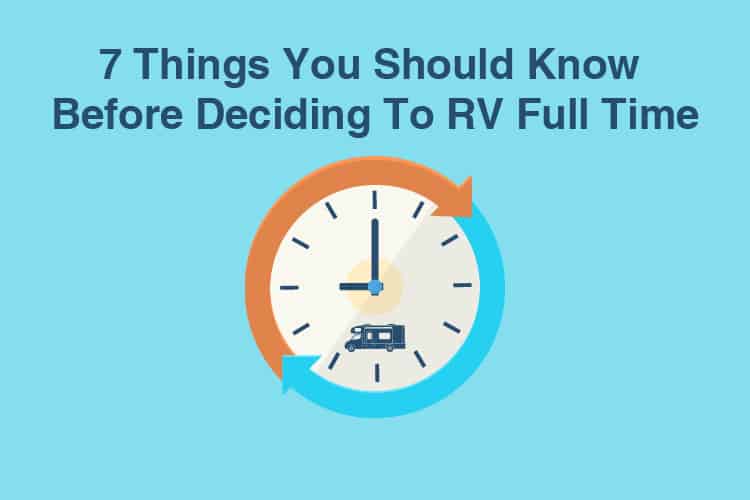

I’m living with my art & business partner in a 33′ camper. We’ve done most of the things mentioned here. We’ve looked at many websites for advice, ideas, tips. This one page has the most complete list that I’ve seen anywhere, over 30 maybe 40 pages I’ve looked at.
Definitely, the metallic bubble wrap makes a big difference. Skirting, too. The space underneath usually is at a temperature between indoor and outdoor temperature, about 1/3 of the way toward indoor temp from the outdoor temp. We use a “milk house heater” with a thermostat, plugged into an outlet that has a built in thermostat, so if it ever gets too warm down there, there are two shut-offs.
To my surprise, A few things didn’t matter at all. Skylights in the roof – I hold my hand right underneath, feel no coolness at all. We have good ones. The small window in the doors – nothing. A few things did matter that I hadn’t thought of at first, such as the table on a metal column. The metal columns mounts into a socket in the floor, and that I suppose is bolted tightly to the metal chassis. All that metal conducting heat away! I wrapped and taped a towel around the column, and that made a noticeable difference in the room’s temperature.
Also, a complication that won’t matter to 99% of camper dwellers – I have a powerful desktop computer with a fancy graphics card, lots of memory, because I do 3D, animation, number crunching for a living. I burn a lot of power on this, and there’s warmth from that. No need to spend $$$ on a heater 🙂